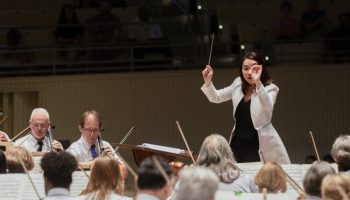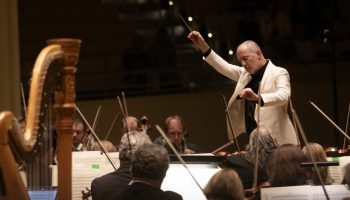
Comedy and tragedy, life and death: the Chautauqua Symphony Orchestra’s next concert is a symphony of opposites.
The CSO will perform “Don Quixote” at 8:15 p.m. Thursday, August 8 in the Amphitheater. The concert features Richard Strauss’ “Don Quixote: Fantastic Variations on a Theme of Knightly Character” and Sergei Rachmaninoff’s “Isle of the Dead.”
Each piece is a symphonic poem — music based on a pre-existing work of art or literature. And like their source material, the pieces explore complex ideas of life and genre.
Don Quixote is an early 17th-century novel by Miguel de Cervantes. Scholars such as Harold Bloom have labeled it as “the first modern novel” for its fledgling use of character development, and its content has inspired centuries of derivative work and literary tropes.
Like the chivalric romances it parodies, Don Quixote is the story of a roaming, adventurous knight — a 50-year-old Spanish nobleman who has lost his grip on reality after reading too much. Quixote and his world-weary “squire,” Sancho Panza, roam the decidedly non-medieval countryside, getting into fights with “giants” (windmills), “enchanters” (friars) and even an “army” (a flock of sheep).
But while the novel has many farcical moments, its tragic elements are clear: Don Quixote is a man swept up in a fantasy, regaining his sanity only in his final moments.
In Strauss’ composition, Quixote is played by the orchestra’s principal cellist: in this case, Jolyon Pegis. Pegis said both tragedy and comedy find their way into Strauss’ musical storytelling.
“It’s got elements of humor and elements of tragedy,” Pegis said. “I think it’s more of a tragedy than it is a comedy, but it’ll have great comedic moments.”
In one such moment, Pegis said, the orchestra’s brass instruments imitate the bleating of Quixote’s wooly enemies.
“There’s a great moment where the orchestra imitates a flock of sheep,” Pegis said. “And then there’s the charge, where Don Quixote attacks the sheep — I think that’s really fun.”
The symphony is composed of 14 shorter sections, including 10 variations that align with chapters from the novel. Pegis’ cello will be the voice of Don Quixote until the character’s tragic final moments.
“The end of the piece is a very poignant, very tragic moment where the character comes to his senses and then dies, so the very last notes that the cello plays are the very last breaths of Don Quixote,” Pegis said. “He’s been living in his fantasy world, and he comes to his senses right at the end.”
CSO Music Director and Conductor Rossen Milanov said the concert is a rare chance to see some of the orchestra’s own musicians as soloists in a complex, challenging piece.
“It’s a showpiece for the orchestra, because anything by Richard Strauss is a demanding, virtuosic type of writing,” Milanov said. “The chance to see Jolyon Pegis as a soloist is, I think, quite remarkable and anticipated by all of us.”
The concert’s opening piece is Rachmaninoff’s “Isle of the Dead.” Rachmaninoff wrote the symphonic poem in 1908, after seeing a black-and-white reproduction of Arnold Böcklin’s painting by the same title.
The painting is a solemn, mysterious scene: In a dark sea, a rocky islet looms, covered in cliffs and cypress trees. A white rowboat approaches it, containing a white-clad figure and a white coffin. Böcklin gave no full explanation to the scene, but described it as “a dream picture; it must produce such a stillness that one would be awed by a knock on the door.”
Milanov said Rachmaninoff’s “Isle of the Dead” is a hidden gem from the famous composer.
“I did not hear it until about 15 years ago,” Milanov said. “But when I heard it for the first time, I was shocked in a very pleasant way at the beauty of the piece — of the haunting quality of it.”
Milanov said the composition explores a mysterious transition between life and death — framed in a dramatic arc.
“Somehow that transition from life to final resting place, which is very solemn, is captured very powerfully in the piece,” Milanov said. “It’s expansive, it’s beautiful and it has this perfect arc of a form that starts one way and finishes exactly the same way, after developing intensely in the middle.”




